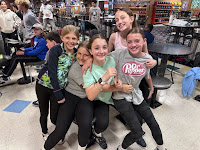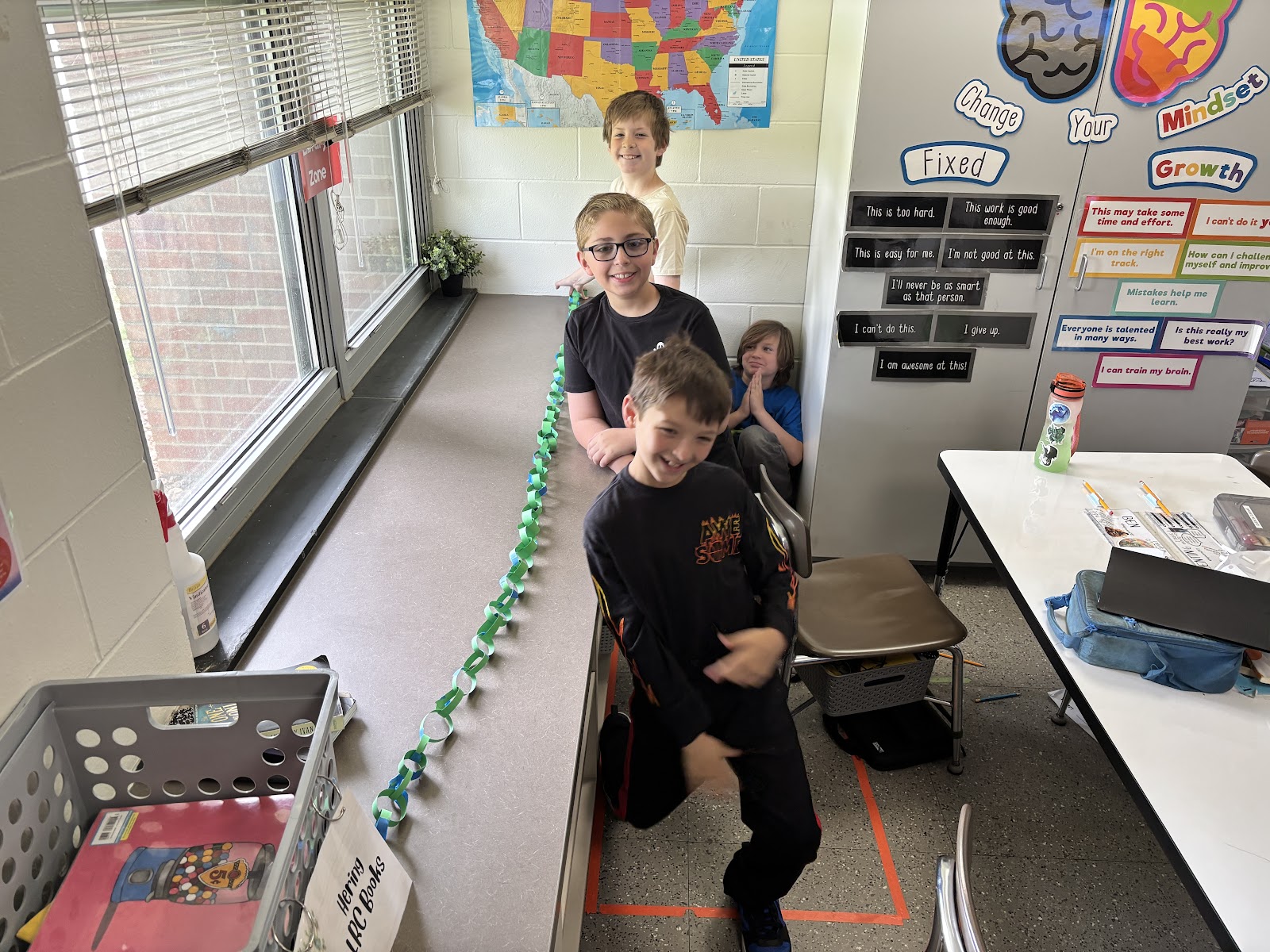Kindergarten has had a wonderful year and has many things to celebrate! We ended our year with an awards ceremony to celebrate all of our accomplishments and growth in Kindergarten. It was an exciting way to conclude our year.
Friday, May 30, 2025
Wednesday, May 28, 2025
Teamwork Makes the Dream Work
Even though we're in our final week of 4th grade, we're still finding new ways to work together as a team! This week, 4th graders tackled the paper chain challenge with their table groups. Each team was given only one piece of construction paper and some tape. Their mission was to create the longest possible paper chain in only 15 minutes.
What happened next was amazing to watch. Students were brainstorming, problem-solving, and figuring out how to cut their paper into the thinnest strips possible. Some teams decided to have one person cutting while others assembled the chain. Other groups took turns with each job. The room was buzzing with excited whispers as they worked together to beat the clock.
When time was up, we measured each chain as a class. The kids were so proud of their teamwork! Then came the big question – could we connect all the chains together and stretch them around our entire classroom? The answer was yes! Our combined paper chains made it all the way around the room, and the kids cheered like they'd just won the championship.
All year long, we've made team building activities like this a regular part of our week. Whether it's problem-solving challenges, group games, or working together on projects, these activities help our students learn to communicate better, respect different ideas, and support each other. As we wrap up the school year, it's clear that our classroom has become more than just a place to learn – it's become a real community where everyone belongs.
Tuesday, May 27, 2025
Our 6th Grade Genius Hour Fair
We had such an awesome time at our 6th Grade Genius Hour Fair this week! The gym was filled with creativity, excitement, and some really cool projects that our students have been working hard on for the past several weeks.
Each student picked a topic they were passionate about and ran with it. Some designed their own video games or built models of roller coasters. Others created inventions, did science experiments, wrote books, or tackled big questions like how to help the environment. Every single project was unique and showed just how creative and capable our students are.It was so fun to watch them share their work. You could see how proud they were as they explained their ideas and showed off what they built or created. Some had posters and presentations, while others brought in physical models or used technology to show what they learned.Thursday, May 22, 2025
Kindergarten Zoo Week!
Kindergarten students have been hard at work preparing for their exciting field trip to the Zoo this week! The students have learned all about various animals they might see at the zoo. Each subject area focused on these zoo animals in some way as an engaging way to learn new things before going on our trip.
In reading, the students learned about a few new animals each day, listened to a story about that animal to find out some facts about where they live, what they eat, about their young, and fun facts. Then, the students learned how to create their own image of the animal, adding in the details they learned from the read-aloud.
In math, the students completed stations each day that were hands-on and used our math manipulatives from this year. We also had a few zoo animal games, such as Addition BUMP and Memory!
In phonics, the students did a write-the-room of our digraph words, played Zoo BINGO, and created a fun animal craft to display in our classroom.
For writing, the students wrote opinion pieces on which animal they would like to play with. At the end of the week, the students also wrote about what their favorite animal is or which they hope to visit on our field trip.
It has been such a fun week learning all about these animals, and the students are definitely excited to go on their field trip tomorrow and meet these animals in real life at the Brookfield Zoo!
Wednesday, May 21, 2025
6th Grade Bowling Field Trip!
I could NOT image a better way to end the year and our bowling unit! The 6th graders had the opportunity to take everything we worked on in PE the last two weeks and put it into action on the REAL lanes!
With the AMAZING support from our Goodrich PTO, we got to go on a Bowling Field trip to Lisle Lanes. All the 6th graders got to bowl at least two games with their group. The cheers and squeals I heard out of these kids when they got a strike or picked up a spare was pure joy!
I hope this is an event I can continue planning in the future. Shout out to Miss Clark, Miss Kaddoura, Miss Berryman and Mrs. Ross for helping to support this event!
THANK YOU GOODRICH PTO!!!!!!!!!!!!!

















Monday, May 19, 2025
3rd Graders Explore the Animal Kingdom
Mrs. Hall’s 3rd-graders embarked on an exciting journey into the animal kingdom. Each student selected an animal category—such as mammals, fish, or birds—and chose three animals within that category to study. Their mission was to uncover fascinating facts about each animal's diet, habitat, and unique traits that define their category. The project began with a focus on nonfiction text features, helping students understand how to gather and organize information effectively. They utilized a variety of online resources to learn about their chosen topics.
Once their research was complete, students turned their attention to publishing. Using the Book Creator app, they designed and assembled their eBooks, incorporating text, images, and even audio recordings to enhance their presentations. This platform allowed them to showcase their creativity while reinforcing their learning.
The culmination of the project was a special event where 3rd graders presented their eBooks to 2nd-grade students from Mrs. Brandner's class. The 2nd graders had a chance to visit each station to learn about a variety of animals.
This animal research project was more than just an academic exercise; it was an opportunity for students to develop essential skills such as research, writing, digital literacy, and public speaking. The success of this project highlights the value of inquiry-based learning and the power of technology in enhancing educational experiences.
Sunday, May 18, 2025
Puppies, Cats, and First Graders…Oh My!
Last Thursday, I had the privilege of joining the first grade students on their field trip to the West Suburban Humane Society. This field trip was a concluding activity for the first grade students’ service learning project. In school, the students made toys for the dogs and cats at the West Suburban Humane Society. Then, on the field trip, the students delivered the toys they made.



































